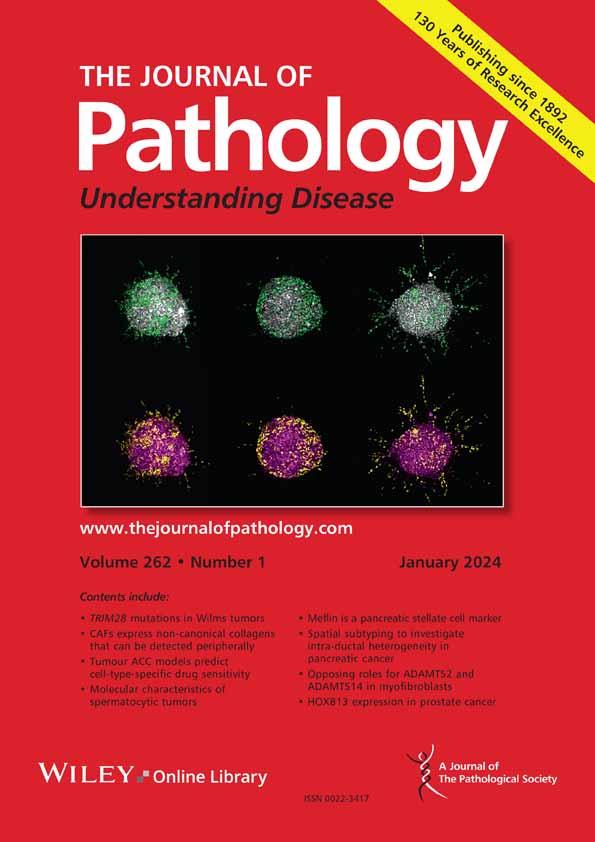Yang Qu, Xiaoli Feng, Hanlin Chen, Fengwei Tan, Anqi Shao, Jiaohui Pang, Qi Xue, Bo Zheng, Wei Zheng, Qiuxiang Ou, Shugeng Gao, Kang Shao
求助PDF
{"title":"多组学分析揭示了I-III期肺微乳头状腺癌的独特分子特征和转化机制。","authors":"Yang Qu, Xiaoli Feng, Hanlin Chen, Fengwei Tan, Anqi Shao, Jiaohui Pang, Qi Xue, Bo Zheng, Wei Zheng, Qiuxiang Ou, Shugeng Gao, Kang Shao","doi":"10.1002/path.6416","DOIUrl":null,"url":null,"abstract":"<p>The micropapillary (MIP) pattern is a high-grade histological subtype of lung adenocarcinoma (LUAD) with poor prognosis. In this study, surgically resected tumor samples from 101 patients with stage I–III MIP–LUAD (MIP ≥30%) were microdissected to separate MIP components from non-MIP components, all of which underwent RNA and DNA whole-exome sequencing (WES). The genomic and transcriptomic landscapes of MIP and non-MIP components within MIP-enriched tumor tissues demonstrated remarkable similarities, notably marked by high epidermal growth factor receptor (EGFR) alteration frequencies. However, when compared to MIP-naïve LUAD tissues, MIP components showed higher chromosomal instability and revealed 18 enriched alterations, encompassing EGFR mutations, EGFR amplifications, and CDKN2A/CDKN2B deletions, which all linked to upregulation of cell proliferation pathways and downregulation of immune pathways. Shared mutations were observed in 97.8% (91/93) of patients with paired DNA WES data for MIP and non-MIP components within the same tissues, suggesting a common origin. The recurrence-free survival analysis identified MACF1, PCLO, ADGRV1, and Fanconi Anemia pathway mutations as negative indicators. In all, we conducted an in-depth analysis of the molecular characteristics and transformation mechanisms of MIP–LUAD, employing microdissection techniques to investigate the genomic and transcriptomic levels within a substantial cohort, providing insights for precision medicine of this aggressive cancer subtype. © 2025 The Pathological Society of Great Britain and Ireland.</p>","PeriodicalId":232,"journal":{"name":"The Journal of Pathology","volume":"266 2","pages":"204-216"},"PeriodicalIF":5.2000,"publicationDate":"2025-03-28","publicationTypes":"Journal Article","fieldsOfStudy":null,"isOpenAccess":false,"openAccessPdf":"","citationCount":"0","resultStr":"{\"title\":\"Multi-omics analyses reveal distinct molecular characteristics and transformation mechanisms of stage I–III micropapillary lung adenocarcinoma\",\"authors\":\"Yang Qu, Xiaoli Feng, Hanlin Chen, Fengwei Tan, Anqi Shao, Jiaohui Pang, Qi Xue, Bo Zheng, Wei Zheng, Qiuxiang Ou, Shugeng Gao, Kang Shao\",\"doi\":\"10.1002/path.6416\",\"DOIUrl\":null,\"url\":null,\"abstract\":\"<p>The micropapillary (MIP) pattern is a high-grade histological subtype of lung adenocarcinoma (LUAD) with poor prognosis. In this study, surgically resected tumor samples from 101 patients with stage I–III MIP–LUAD (MIP ≥30%) were microdissected to separate MIP components from non-MIP components, all of which underwent RNA and DNA whole-exome sequencing (WES). The genomic and transcriptomic landscapes of MIP and non-MIP components within MIP-enriched tumor tissues demonstrated remarkable similarities, notably marked by high epidermal growth factor receptor (EGFR) alteration frequencies. However, when compared to MIP-naïve LUAD tissues, MIP components showed higher chromosomal instability and revealed 18 enriched alterations, encompassing EGFR mutations, EGFR amplifications, and CDKN2A/CDKN2B deletions, which all linked to upregulation of cell proliferation pathways and downregulation of immune pathways. Shared mutations were observed in 97.8% (91/93) of patients with paired DNA WES data for MIP and non-MIP components within the same tissues, suggesting a common origin. The recurrence-free survival analysis identified MACF1, PCLO, ADGRV1, and Fanconi Anemia pathway mutations as negative indicators. In all, we conducted an in-depth analysis of the molecular characteristics and transformation mechanisms of MIP–LUAD, employing microdissection techniques to investigate the genomic and transcriptomic levels within a substantial cohort, providing insights for precision medicine of this aggressive cancer subtype. © 2025 The Pathological Society of Great Britain and Ireland.</p>\",\"PeriodicalId\":232,\"journal\":{\"name\":\"The Journal of Pathology\",\"volume\":\"266 2\",\"pages\":\"204-216\"},\"PeriodicalIF\":5.2000,\"publicationDate\":\"2025-03-28\",\"publicationTypes\":\"Journal Article\",\"fieldsOfStudy\":null,\"isOpenAccess\":false,\"openAccessPdf\":\"\",\"citationCount\":\"0\",\"resultStr\":null,\"platform\":\"Semanticscholar\",\"paperid\":null,\"PeriodicalName\":\"The Journal of Pathology\",\"FirstCategoryId\":\"3\",\"ListUrlMain\":\"https://pathsocjournals.onlinelibrary.wiley.com/doi/10.1002/path.6416\",\"RegionNum\":2,\"RegionCategory\":\"医学\",\"ArticlePicture\":[],\"TitleCN\":null,\"AbstractTextCN\":null,\"PMCID\":null,\"EPubDate\":\"\",\"PubModel\":\"\",\"JCR\":\"Q1\",\"JCRName\":\"ONCOLOGY\",\"Score\":null,\"Total\":0}","platform":"Semanticscholar","paperid":null,"PeriodicalName":"The Journal of Pathology","FirstCategoryId":"3","ListUrlMain":"https://pathsocjournals.onlinelibrary.wiley.com/doi/10.1002/path.6416","RegionNum":2,"RegionCategory":"医学","ArticlePicture":[],"TitleCN":null,"AbstractTextCN":null,"PMCID":null,"EPubDate":"","PubModel":"","JCR":"Q1","JCRName":"ONCOLOGY","Score":null,"Total":0}
引用次数: 0
引用
批量引用






 求助内容:
求助内容: 应助结果提醒方式:
应助结果提醒方式:


